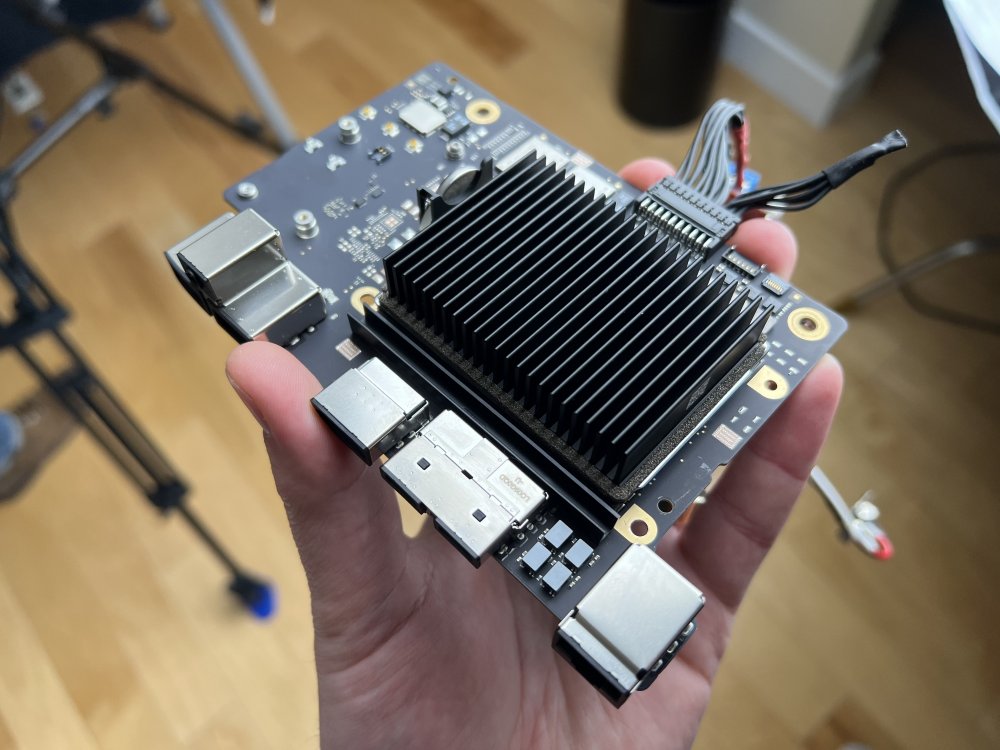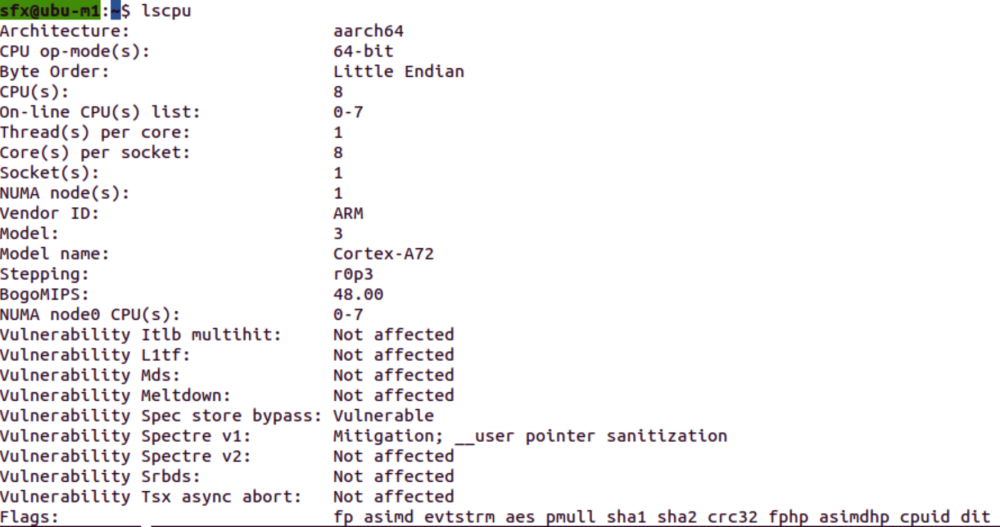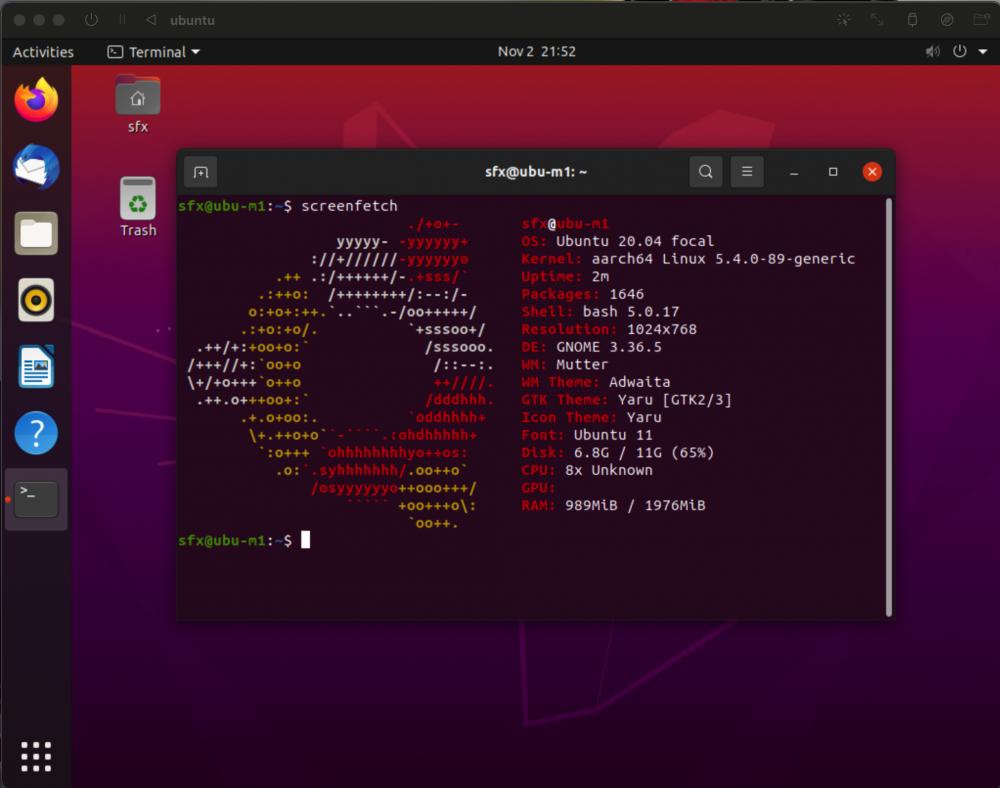
sfx2000
-
Posts
631 -
Joined
-
Last visited
Content Type
Forums
Store
Crowdfunding
Applications
Events
Raffles
Community Map
Posts posted by sfx2000
-
-
Picked up a couple of these over at the local second hand store...
https://www.aopen.com/AU_en/products_info/Chromebox-Mini
My guess is that these were digital signage oriented, as they were in a crate with a few Startech USB-DVI adatpers, etc...
Anyways - they're end-of-support for ChromeOS... There's a couple of posts over on Alpine to get things running there...
It's close enough to TinkerBoard to maybe do some effort, and with Chromeboxes/Chromebooks on the same SoC/BSP...
-
-
Grabbed the latest Jammy download for NanoPi Neo 2 - https://redirect.armbian.com/nanopineo2/Jammy_current
Have to ask - why servers preinstalled and default configured?
I found NFS/rpcbind and OpenVPN preinstalled on the image - this is a security risk that can be easily avoided.
-
cloud is preferred - that being said, if it is sensitive, or even classified, data, this is the wrong forum to be in.
We're not the ones to comment on any approach here - most companies and organizations have strong policy guidance as to how their data is handled.
-
Seems like nobody has responded...
Yes, a Macbook Air M1 is a nice machine and works well with iOS via iCloud.
-
On 2/25/2022 at 6:20 AM, gounthar said:
I can't afford a Ampere eMag and use a 32 bits userspace, and I'm trying to buya 2nd hand SolidRun HoneyComb, but it's also a 64 bits machine.
Thanks!Something to consider for your CI/CD pipeline...
https://www.servethehome.com/oracle-cloud-giving-away-ampere-arm-a1-instances-always-free/
There is always AWS, but that ain't free...
-
-
On 7/3/2021 at 11:35 AM, peterbmckinley said:
With ST Microelectronics move into the MPU space, there is a lot of potential growth for a mature and trusted US brand with the integrity to provide proper documentation
Free hardware can be provided if required. Free stuff. Just sayin'
Part of the challenges working with folks like STM is getting ahold of the right folks that can actually help without needing NDA's and all that...
They already have a debian buster image available, so with the right setup on the host side, pretty much it's a done project.
I just wrapped up something similar for embedded on a Microchip SAMA5D series SoC, not looking to pull in something else for the moment.
-
-
-
Exactly - MV3720 running in 64-bit is fairly impressive all told, which is why I kind of mentioned that one might be better off rather than using CESA on that chip.
Armada 38X and XP, it's the other way around, where CESA is much better than running on cores - benefit of those chips being focused on networking/communications processing as opposed to application focused..
Depending on needs of course - the main benefit of running CESA is the offload from the cores so they are available for other tasks.
-
Was kind of seeing if anyone would mention things, since the processor has been out for better part of a year now...
Spoiler% uname -a
Darwin astro 21.1.0 Darwin Kernel Version 21.1.0: Wed Oct 13 17:33:24 PDT 2021; root:xnu-8019.41.5~1/RELEASE_ARM64_T8101 arm64
Asahi team is making good progress at bringing up the kernel at a board level, so one could probably bring debain into userland with not much effort.
Homebrew folks have made the port over from x86_64 to arm64 recently, so toolchain support should be a bit better.
Looking below - nice finegrained clocks for CPU/GPU on the chip - note that the cores are individually clocked...
Spoiler**** Processor usage ****
E-Cluster Power: 15 mW
E-Cluster HW active frequency: 1007 MHz
E-Cluster HW active residency: 10.89% (600 MHz: 7.8% 972 MHz: 85% 1332 MHz: 1.7% 1704 MHz: 1.9% 2064 MHz: 4.0%)
E-Cluster idle residency: 89.11%
E-Cluster instructions retired: 8.61832e+08
E-Cluster instructions per clock: 1.02599
CPU 0 frequency: 1169 MHz
CPU 0 idle residency: 94.42%
CPU 0 active residency: 5.58% (600 MHz: .13% 972 MHz: 4.0% 1332 MHz: .32% 1704 MHz: .56% 2064 MHz: .57%)
CPU 1 frequency: 1205 MHz
CPU 1 idle residency: 95.53%
CPU 1 active residency: 4.47% (600 MHz: .08% 972 MHz: 3.1% 1332 MHz: .31% 1704 MHz: .37% 2064 MHz: .63%)
CPU 2 frequency: 1207 MHz
CPU 2 idle residency: 97.43%
CPU 2 active residency: 2.57% (600 MHz: .04% 972 MHz: 1.8% 1332 MHz: .21% 1704 MHz: .19% 2064 MHz: .37%)
CPU 3 frequency: 1382 MHz
CPU 3 idle residency: 97.52%
CPU 3 active residency: 2.48% (600 MHz: .01% 972 MHz: 1.2% 1332 MHz: .29% 1704 MHz: .31% 2064 MHz: .63%)
P-Cluster Power: 56 mW
P-Cluster HW active frequency: 671 MHz
P-Cluster HW active residency: 3.67% (600 MHz: 93% 828 MHz: .91% 1056 MHz: 2.3% 1284 MHz: .72% 1500 MHz: .65% 1728 MHz: .31% 1956 MHz: .23% 2184 MHz: .08% 2388 MHz: .17% 2592 MHz: .27% 2772 MHz: .19% 2988 MHz: .14% 3096 MHz: .09% 3144 MHz: .08% 3204 MHz: .77%)
P-Cluster idle residency: 96.33%
P-Cluster instructions retired: 9.81091e+08
P-Cluster instructions per clock: 2.97139
CPU 4 frequency: 1456 MHz
CPU 4 idle residency: 97.85%
CPU 4 active residency: 2.15% (600 MHz: .05% 828 MHz: .26% 1056 MHz: .67% 1284 MHz: .27% 1500 MHz: .14% 1728 MHz: .31% 1956 MHz: .21% 2184 MHz: .07% 2388 MHz: 0% 2592 MHz: .04% 2772 MHz: .00% 2988 MHz: .01% 3096 MHz: 0% 3144 MHz: .01% 3204 MHz: .12%)
CPU 5 frequency: 2086 MHz
CPU 5 idle residency: 98.23%
CPU 5 active residency: 1.77% (600 MHz: .01% 828 MHz: .11% 1056 MHz: .40% 1284 MHz: .21% 1500 MHz: .09% 1728 MHz: 0% 1956 MHz: .00% 2184 MHz: .02% 2388 MHz: .17% 2592 MHz: .08% 2772 MHz: .09% 2988 MHz: .09% 3096 MHz: .08% 3144 MHz: 0% 3204 MHz: .42%)
CPU 6 frequency: 1701 MHz
CPU 6 idle residency: 99.86%
CPU 6 active residency: 0.14% (600 MHz: .00% 828 MHz: .02% 1056 MHz: .01% 1284 MHz: .04% 1500 MHz: .04% 1728 MHz: 0% 1956 MHz: 0% 2184 MHz: .00% 2388 MHz: 0% 2592 MHz: 0% 2772 MHz: 0% 2988 MHz: .00% 3096 MHz: 0% 3144 MHz: 0% 3204 MHz: .03%)
CPU 7 frequency: 2700 MHz
CPU 7 idle residency: 99.96%
CPU 7 active residency: 0.04% (600 MHz: .00% 828 MHz: .00% 1056 MHz: .00% 1284 MHz: 0% 1500 MHz: 0% 1728 MHz: 0% 1956 MHz: 0% 2184 MHz: 0% 2388 MHz: 0% 2592 MHz: 0% 2772 MHz: 0% 2988 MHz: 0% 3096 MHz: 0% 3144 MHz: 0% 3204 MHz: .03%)
System instructions retired: 1.84292e+09
System instructions per clock: 1.57491
ANE Power: 0 mW
DRAM Power: 11 mW
CPU Power: 71 mW
GPU Power: 2 mW
Package Power: 85 mW
**** GPU usage ****
GPU active frequency: 3 MHz
GPU active residency: 0.87% (396 MHz: .87% 528 MHz: 0% 720 MHz: 0% 924 MHz: 0% 1128 MHz: 0% 1278 MHz: 0%)
GPU requested frequency: (396 MHz: .87% 528 MHz: 0% 720 MHz: 0% 924 MHz: 0% 1128 MHz: 0% 1278 MHz: 0%)
GPU idle residency: 99.13%
GPU Power: 2 mW
Will be nice to see what newer ARM cores bring to the table - looking forward to Cortex-A78
sfx
-
On 9/8/2021 at 4:03 PM, m4110c said:
So I wonder how/why you think not using CESA is better here. From my point of view this seems to be a contradiction. Or is there something I don't see?
Armada 38x is fairly decent with CESA in specific use cases - and it's worth the effort perhaps to get it up and running (armbian, if I recall, doesn't enable it by default)
MV3720 is a different chip - and there, it's better to skip the CESA units, and go with software on the cores, IMHO...
-
On 1/17/2021 at 5:51 PM, MarkLuun said:
As the title already says, I would like to know what the best 5V SBC`s are to be used as network relay? The board should have a minimum of 1,5 GB RAM and it should be able to handle about (or even more then) 50 MBit/s synchronous network bandwidth by ethernet plug 24/7.
Atheros 9331 can do this all day long on 100-Base-T... 400MHz MIPS32
[SUM] 0.00-10.00 sec 102 MBytes 85.5 Mbits/sec sender [SUM] 0.00-10.00 sec 101 MBytes 84.4 Mbits/sec receiver64MB RAM/16MB SPI-NOR - running OpenWRT
If you need a bit more horsepower to route traffic - MV3720 on Gigabit can do wire speed there...
Alternate for 1GB - QCA IPQ-40xx - I've got a IPQ-4019 board running QSDK (based on an older OpenWRT with QCA special sauce), and it can route actually better than the MV3720 - and that's a QuadCore Cortex-A7...
Key thing here - AR9331/MV3720/IPQ4019 - these are all communications focused devices, not application processors/boards...
-
On 2/2/2021 at 3:27 AM, dolphs said:
I added an USB3.0 adapter to my rockpi4a , which results in: " enx000ec667f0a2 " ( eth1 )
Since NetworkManager is being used I tried to update this name using : " nmcli c modify armbian connection.interface-name "eth1" "
But alas that does not seem to be picked up while nmconnection config file has been updated:
Shortcut perhaps... but this does override systemd assigning things there...
Add the following line to /boot/armbianEnv.txt
extraargs=net.ifnames=0and then reboot...
sfx
-
On 10/17/2020 at 11:03 AM, NicoD said:
It's like if my girlfriend and ex-girfriend became good friends.
Indeed - and they both get along, and want to do a threesome.... It's so very wrong and right on many levels, LOL, and rarely ends well

That being said - Microsoft is a very different company that it was under Gates/Ballmer with Windows/Office at all costs...
WSL on Win10 for example, as well at the beast that is Azure...
Embrace/Extend/Overcome?
Who knows...
sfx
-
On 10/17/2020 at 1:03 AM, Igor said:
If you are running Armbian desktop and you like to use Visual Studio Code,
Nice to see VS Code in the repo's - it's my goto editor these days on Mac/Win/Linux..
On lower end ARM's - it's a bit slow and memory intense, but it does run...
The RPI folks recently added it to their debian based distro in the last couple of weeks...
-
On 1/17/2021 at 12:55 PM, JMCC said:
Some day I have to test this ZFS. I'm too attached to the good ol' EXT4
ZFS support is nice to have - one can use EXT4 for the boot volume, and ZFS for attached drives as a storage pool...
That being said, ZFS can, and often does, use more memory...
-
On 1/12/2021 at 7:37 PM, mathieuh said:
A few things I've noticed:
- The gmac ethernet device naming seems unstable. It usually comes up as `eth1` but sometimes come up as `eth0`. It seems to depend on timing when the r8169 pci adapter is brought up (in the first case it's named `eth0` before being renamed to the stable `enp1s0`). Is there precedent in armbian to force the integrated adapter to a more stable name such as `eno1` ?
- When I first played with the official 20.11.05 build, I experienced the r8169 pci adapter sometimes not being detected on command line reboots (with cable plugged in if that makes a difference). I didn't see anything particular in the logs besides the device completely missing. I'll see if I can reproduce again and post the logs.
u-boot and device tree optimizing works wonders here - need to declare the interfaces before the kernel boots, otherwise it's going to grab the first one ready...
-
16 hours ago, Igor said:
Why not let people have the best shell OOB? "It will spoil you rotten. Its features are so much more powerful than Bash, you'll never be happy with Bash ever again.". I manage to tweak it that it works fast also on slowest machine. Its my daily driver - I can trade anything, just not ZSH.
"best" is subjective - yes zsh is nice, and now the default shell even on MacOS BigSur.
I'm a bit old-school - bash is good enough for me, I know it's quirks, and zsh (or others) is always an option post first-boot.
On my other efforts - I'm still dealing with busybox (and that is ash.c)...
-
19 hours ago, Werner said:
This isn't an entire shell or? More a screen competitor?
Screen/Tmux - pretty nifty, and it's in the repo's so one can play with it, and define as the default shell if one prefers...
-
I'd suggest putting this in armbian-config to enable (along with the options for tmux, etc) and leave bash as default...
Also look at byobu - this is an ubuntu sanctioned environment, and pretty handy - it's my go-to for working on the shell...
-
Just curious as to why proposing to change the default shell from bash to zsh?
u-boot updates - agree/concur where applicable.
Desktop vs Master/Mainline merge - depends on 3D support (I'd recommend not by default), and blob-space - this seems to be the bigger topic...
-
Tesla's own fault...
1) 8GB eMMC is going to have a fair amount of writes if logging direct to disk - and each write there is two writes, one to erase a block, and one to rewrite the entire block.
2) Reminds me of a handset vendor about 7 years ago, where they would write a time value every second to eMMC - after about 9 months, the device would die...
sfx





Aopen ME4100 - Chromebox - RK3288C
in Rockchip CPU Boxes
Posted
Converting Chrome devices over - each one is a bit different, and each one takes perhaps more skill on the user to get there...
Here's the Alpine link...
https://wiki.alpinelinux.org/wiki/Alpine_on_the_Aopen_Chromebase_or_Chromebox_Mini_with_Mainline_Kernel